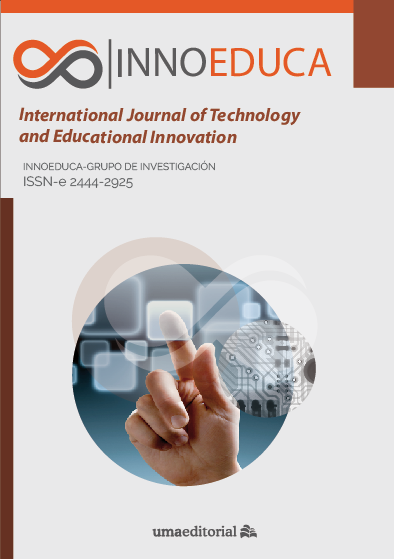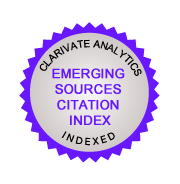Gamified paradigms published in edublogs for Secondary Education, Vocational Education and Upper Secondary
DOI:
https://doi.org/10.24310/innoeduca.2022.v8i1.10299Keywords:
educational games, educational technology, Web 2.0 technologies, Secondary Education, Vocational Education, Upper SecondaryAbstract
The use of Information and Communication Technologies (ICT) as a motivating element for learning as well as teachers’ concern about educational innovation are key elements in the inclusion of gamified proposals in schools. Educational gamification introduces typical elements of games in the classroom and the use of ICT as a tool to facilitate the teaching-learning process. The aim of this study is to classify, structure, and analyse the gamified systems that teachers display on the Internet through blogs. By means of a descriptive, non-experimental methodological design supported by data obtained from educational blogs, 111 edublogs with gamified experiences related to the educational stages of Secondary Education, Training Cycles, and Baccalaureate are analysed, and they contain at least four of the following game-based components: points, badges, classification tables, progress bars, missions or tasks, medals, rewards for effort or uncertain rewards, feedback, and interaction between players. The homogeneity in the constructs considered indicates that teachers become aware of their own identity as a facilitator of ICT-assisted play systems. The educational technology adopted reveals passive activity on the part of the students, who are the recipients of a system whose educational objectives are built around a change of attitude or an increase in motivation for the subject. An ample use of technological tools necessary to execute an efficient gamified system is detected, as well as the value of their use to motivate learning. Aspects such as the absence of interactions on blogs and the analysis of ICT tools used lead us to consider that the student’s role is limited to a mere recipient of rules, points, and badges in exchange for traditional tasks.
Downloads
Metrics
Publication Facts
Reviewer profiles N/A
Author statements
Indexed in
-
—
- Academic society
- N/A
- Publisher
- Universidad de Málaga
References
Álvarez, A., Álvarez-Ossorio, A., Cidoncha, F., & Sánchez, V. (2018). El uso del Kahoot y del Jumble como herramienta de trabajo para la enseñanza para la Historia Antigua y Medieval de España. En M. Rodríguez López, R. Anguita Martínez (Ed.), Innovaciones en el aprendizaje con tecnologías digitales (pp. 97-108). Egregius.
Angelini, M. L., & García-Carbonell, A. (2015). Percepciones sobre la Integración de Modelos Pedagógicos en la Formación del Profesorado: La Simulación y Juego y El Flipped Classroom. Education in the Knowledge Society (EKS), 16(2), 16-30. https://doi.org/10.14201/eks20151621630
Araújo, I. (2016). Gamification: Metodología para envolver y motivar alumnos en el proceso de aprendizaje. Education in the Knowledge Society (EKS), 17(1), 87-108. https://doi.org/10.14201/eks201617187107
Area, M., Hernández, V. M., & Sosa, J. J. (2016). Modelos de integración didáctica de las TIC en el aula. Comunicar: Revista científica iberoamericana de comunicación y educación, (47), 79-87.
Ariza, A. (2015). Estudio descriptivo sobre el uso del blog educativo en Educación Física. Lecturas: Educación física y deportes, (205), 1-4.
Arranz, J. C. (2018). Star Maths. Gamificación de Matemáticas en l0 y 2° de la ESO. En V. Arufe & M. Abilleira (Coords.), 21 proyectos y experiencias innovadoras para el aula de educación secundaria y bachiller (pp. 67-81). Educa.
Balagué, F. M. (2009). Ús dels blogs com a suport al procés d’ensenyament i aprenentatge a l’educació superior (Ph.D. Thesis, Universitat de Barcelona). TDX. http://www.tdx.cat/handle/10803/2944
Baldeón, J., Rodríguez, I., Puig, A., & López, M. (2017). Evaluación y rediseño de una experiencia de gamificación en el aula basada en estilos de aprendizaje y tipos de jugador. En R.S. Contreras, & J.L. Eguia (Coords.), Experiencias de gamificación en aulas (pp. 95-112). INCOM- UAB.
Bort, M. C. (2014). La potencialidad del blog para el desarrollo del diálogo reflexivo: Un estudio empírico en la Formación Profesional (Ph.D. Thesis, Universitat de Lleida). TDX. http://www.tdx.cat/handle/10803/285630
Buckingham, D. (2008). Más allá de la tecnología. Aprendizaje infantil en la era de la cultura digital. Manantial.
Burke, B. (2016). Gamify: How Gamification Motivates People to Do Extraordinary Things. Routledge. https://doi.org/10.4324/9781315230344
Cabañes, E., & Rubio, M. (2013). Gamestar(t): Pedagogías libres en la intersección entre el arte, la tecnología y los videojuegos. SELLO ARSGAMES.
Casas, N., Ballesteros, D., & Etxeandia, E. (2018). Math Mystery Box: Gamificando el aprendizaje de las matematicas. Pensamiento Matemático, 8(2), 101-108.
Chatfield, T. (2010). Fun Inc.: Why Gaming Will Dominate the Twenty-First Century. https://cutt.ly/ntDKeWy
Coll, C. (2013). La educación formal en la nueva ecología del aprendizaje: Tendencias, retos y agenda de investigación. En J. L. Rodríguez Illera (Ed.), Aprendizaje y educación en la sociedad digital (pp. 156-170). Universitat de Barcelona. https://doi.org/10.1344/106.000002060
Coll, C., & Monereo, C. (2008). Psicología de la educación virtual. Aprender y enseñar con las tecnologías de la información y la comunicación. https://mediacaotecnologica.files.wordpress.com/2012/08/psicologia-de-la-educacion-virtual-coll-y-monereo.pdf
Contreras, R. S. (2017). Gamificacion en escenarios educativos: Revisando. En R.S. Contreras, & J.L. Eguia (Coords.), Experiencias de gamificación en aulas (pp. 11-17). INCOM- UAB.
Corchuelo, C. A. (2018). Gamificación en educación superior: Experiencia innovadora para motivar estudiantes y dinamizar contenidos en el aula. Edutec. Revista Electrónica de Tecnología Educativa, (63), 29-41 (380). https://doi.org/10.21556/edutec.2018.63.927
Deterding, S., Sicart, M., Nacke, L., O’Hara, K., & Dixon, D. (2011). Gamification. Using Game-design Elements in Non-gaming Contexts. CHI ’11 Extended Abstracts on Human Factors in Computing Systems (pp. 2425–2428). ACM. https://doi.org/10.1145/1979742.1979575
Endarto, I. (2017). Gamifying Language Testing through Web-Based Platforms. Advances in Social Science, Education and Humanities Research, 145, 130-134. https://doi.org/10.2991/iconelt-17.2018.29
Escamilla, A. (2016). La competencia para aprender a aprender en educación secundaria obligatoria: Fundamentos y herramientas de un programa integrado para su desarrollo (Tesis doctoral, Universidad Complutense de Madrid). E-Prints Complutense. https://eprints.ucm.es/40506/1/T38140.pdf
Fuentes, M., & González, J. (2017). Necesidades formativas del profesorado de Secundaria para la implementación de experiencias gamificadas en STEM. RED: Revista de Educación a Distancia, (54), 9. https://revistas.um.es/red/article/view/298881
Gómez, I. M. (2018). Gamificación y tecnologías como recursos y estrategias innovadores para la enseñanza y aprendizaje de la historia. Educação & Formação, 3(8), 3-16. https://doi.org/10.25053/redufor.v3i8.267
González-Sanmamed, M., Sangrá, A., Souto A., & Estévez, I. (2018). Ecologías de aprendizaje en la Era Digital: Desafíos para la Educación Superior. Publicaciones, (48), 11-38. https://doi.org/10.30827/publicaciones.v48i1.7329
Gutiérrez, M. L. (2017). El blog como herramienta educativa para Educación Secundaria. Su uso en la materia de música (Tesis Doctoral, Universidad Carlos III de Madrid). e-Archivo UC3M. https://e-archivo.uc3m.es/handle/10016/25560
Huizinga, J. (1949). Homo Ludens (2014.a ed.). Routledge.
Hunicke, R., Leblanc, M., & King, W. (2004). MDA: A Formal Approach to Game Design and Game Research. Game Desings and Tuning Workshop [Conference presentation]. Game Developers Conference, San José, Costa Rica. https://cutt.ly/4tDKCW0
Kapp, K. M. (2012). The Gamification of Learning and Instruction: Game-based Methods and Strategies for Training and Education. John Wiley & Sons.
Kim, J., & Castelli, D. M. (2021). Effects of Gamification on Behavioral Change in Education: A Meta-Analysis. International Journal of Environmental Research and Public Health, 18(7), e3550. https://doi.org/ 10.3390/ijerph18073550
Labrador, E., & Villegas, E. (2016). Unir Gamificación y Experiencia de Usuario para mejorar la experiencia docente. RIED: revista iberoamericana de educación a distancia, 19(2), 125-142.
Marín, V. I., & Donoso, J. (2014). El uso del blog de aula como recurso complementario de la enseñanza presencial para el intercambio de información e interacción entre el profesorado y alumnado de primer año de química. Educación Química, 25, 183-189. https://doi.org/10.1016/S0187-893X(14)70557-9
Marks, J. (2013). Gamification: Using game-like elements to redesign our classrooms. https://rethinked.org/?p=3369
Martín, A. M., & Montilla, M. del V. C. (2015). El uso del blog como herramienta de innovación y mejora de la docencia universitaria. Profesorado, Revista de Currículum y Formación del Profesorado, 20(3), 659-686.
Molina, P., Valenciano, J., & Valencia-Peris, A. (2015). Los blogs como entornos virtuales de enseñanza y aprendizaje en Educación Superior. Revista Complutense de Educación, 26, 15-31. https://doi.org/10.5209/rev_RCED.2015.v26.43791
Nor, M., & Wong, S. Y. (2008). Game based learning model for history courseware: A preliminary analysis [Conference presentation]. International Symposium on Information Technology (pp. 1-8). IEEE. https://doi.org/10.1109/ITSIM.2008.4631565.
Ortiz-Colón, A.-M., Jordán, J., & Agredal, M. (2018). Gamificación en educación: Una panorámica sobre el estado de la cuestión. Educação e Pesquisa, 44, e173773. https://doi.org/10.1590/s1678-4634201844173773
Ouariachi, T., Li, C. Y., & Elving, W. J. (2020). Gamification approaches for education and engagement on pro-environmental behaviors: Searching for best practices. Sustainability, 12(11), e4565. https://doi.org/10.3390/su12114565
Pascual, V., Moreno, D., & Palacio, A. (2016). Implementación de metodologías activas en un aula virtual para la formación de docentes de secundaria. En R. Roig (Coord.), Tecnología, innovación e investigación en los procesos de enseñanza-aprendizaje (pp. 1045-1054). Octaedro.
Pascuas, Y. S., Vargas, E. O., & Muñoz, J. I. (2017). Experiencias motivacionales gamificadas: Una revisión sistemática de literatura. Innovación Educativa, 17(75), 63-80.
Pastor, H., Satorre, R., Molina-Carmona, R., Gallego-Durán, F. J., & Llorens, F. (2015). Can Moodle be used for structural gamification? [Conference presentation]. In International Association of Technology, Education and Development (IATED), (Ed.), Proceedings of INTED2015 Conference (pp. 1014-1021). INTED. http://rua.ua.es/dspace/handle/10045/45848
Pelling, N. (2011, agosto 9). The (short) prehistory of “gamification”. https://nanodome.wordpress.com/2011/08/09/the-short-prehistory-of-gamification/
Perdomo, I. R., & Rojas, J. A. (2019). La ludificación como herramienta pedagógica: Algunas reflexiones desde la psicología. REXE- Revista de Estudios y Experiencias en Educación, 18(36), 161-175.
Portillo, M. C. P., Cano, E., & Giné, N. (2012). La escritura de blogs para la evaluación de competencias del prácticum de formación del profesorado. Bordón. Revista de Pedagogía, 64(4), 63-81. https://recyt.fecyt.es/index.php/BORDON/article/view/22059
Pozo, S., López, J., & Moreno, A. J. (2018). El blog como herramienta dinamizadora en el aula de Educación Secundaria [Comunicación congreso]. En II Congreso Internacional Virtual de Investigación e Innovación Educativa (pp. 24-25). Adaya Press.
Rosselló, M., & Pinya, C. (2017). Using blogs to improve professional competencies among undergraduate students. Digital Education Review, (31), 20-38. https://doi.org/10.1344/der.2017.31.20-38
Ryan, R. M., & Deci, E. L. (2019). Brick by Brick: The Origins, Development, and Future of Self-Determination Theory. En A. J. Elliot (Ed.), Advances in Motivation Science (pp. 111-156). Elsevier. https://doi.org/10.1016/bs.adms.2019.01.001
Solihin, I., Sumardi, & Umamah, N. (2019). Interactive Weblog as a Source of Social Study of Junior High School Students. IOP Conference Series: Earth and Environmental Science, 243(1), 012086. https://doi.org/10.1088/1755-1315/243/1/012086
Soto, R., Sanz, M., & Boumadan, M. (2020). La realidad de la brecha de conectividad en el ámbito educativo español: Análisis de la situación actual. Innoeduca. International Journal of Technology and Educational Innovation, 6(1), 56-65. https://doi.org/10.24310/innoeduca.2020.v6i1.7741
Swacha, J. (2021). State of Research on Gamification in Education: A Bibliometric Survey. Educ. Sci. 2021, 11, e69. https://doi.org/10.3390/educsci11020069
Teixes, F. (2014). Gamificación: Fundamentos y aplicaciones. Editorial UOC.
Trejo González, H. (2019). Recursos tecnológicos para la integración de la gamificación en el aula. Revista Tecnología, Ciencia y Educación, (13), 75-117.
Vargas, Z. L., Rodriguez, A. A., & Sanchez, C. L. (2020). Digital games (Gamification) in Learning and Training: an Approach to Adaptation and Integration in the Classroom. GIST – Education and Learning Research Journal, 20, 171-188. https://doi.org/10.26817/16925777.765
Werbach, K., & Hunter, D. (2012). For the Win: How Game Thinking Can Revolutionize Your Business. Wharton Digital Press.
Yuste, R., Esnaola, G., & Ansó, M. B. de. (2017). Buenas prácticas de enseñanza con juegos digitales [Comunicación en congreso]. V Congreso Internacional de Videojuegos y Educación (CIVE’17). Lleida, España.
Zichermann, G., & Linder, J. (2013). The Gamification Revolution: How Leaders Leverage Game Mechanics to Crush the Competition. McGraw-Hill Education.
Downloads
Published
How to Cite
Issue
Section
License
All contents published by Innoeduca. International Journal of Technology and Educational Innovation are subject to Creative Commons Attribution-Nocomercial-NoDerivatives 4.0 International License, whose complete text can be consulted at https://creativecommons.org/licenses/by-nc-nd/4.0/legalcode. Thus, copying, distribution, public communication, derivative works and commercial use of content are permitted as of the aforementioned issue provided that the source and the author of the text are cited.
It is the responsibility of the authors to obtain the necessary permits for images that are subject to copyright.

This work is licensed under a Creative Commons Attribution-NonCommercial-NoDerivatives 4.0 International License.













242.png)








